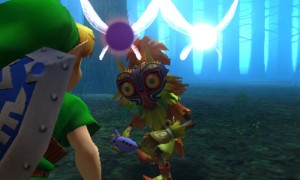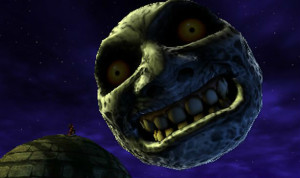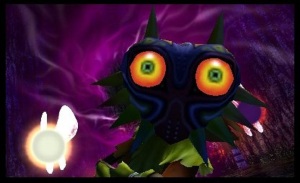I was out to dinner with a good friend when I got my review code for The Legend of Zelda: Majora’s Mask 3D and I shouted joyously at a volume that some may have considered to be inappropriate.
It is no secret that I am a big fan of Majora’s Mask and bring up my love for it whenever it is even remotely relevant for me to do so, much to the dismay of Lusipurr. What is probably less well-known however is the fact that I have only completed the game once, and even then, a friend played the Stone Tower Temple dungeon while I watched because it was his favourite part. This was back in high school.
My review next week will deal more directly with the question of what I still consider to be strong, what does not hold up as well as I remembered, and what elements I never noticed the first time I played it.
Unfortunately, I do not have a New 3DS to test out the camera nub nor the improved 3D (which – according to those who have tried it – is a marked improvement leading to long sessions with the 3D turned on), but the game obviously has upgrades and changes that have nothing to do with new hardware, so I am going to let those changes be the main focus for our time together today, LusiMoons.
Majora’s Mask revolves around a highly intricate set of repeating events that crisscross all around the land of Termina, and converge in the central hub that is Clock Town. One of the main joys of the game is slowly becoming familiar with the actions of everybody, resulting in a Groundhog Day-esque mastery of the world that rises in parallel with a sense of loneliness that comes with almost everybody’s memory constantly being wiped except Link. To keep track of all these people and events, the game employs a record-keeping notebook that displays the characters that Link has met and at what point during which days they are doing something important.
In the original, when a character was added to the notebook, their schedules would be automatically filled in with the day and time they would need to be interacted with to further or complete a quest, albeit without the conditions needed nor the appropriate location. In Majora’s Mask 3D, even this information is missing, but is instead supplemented by an all-new portion of the notebook that looks and acts much more like a traditional quest log. Details of the quest are provided in text along with an icon that displays if the action Link took was successful and is grayed out when events were completed, but in a previous three-day cycle and before the larger quest in question was completed. More characters are added to the notebook as well so that players can keep better track of quests that are not mask-related (which were the only included quests in the notebook in the original).
Overall the change seems to be a positive one. Keeping track of quests is a much simpler task and Majora’s Mask 3D accomplishes this without hand-holding or watering down the experience. Well, for the most part. With more text comes a little less mystery and it is mystery and a sense of accomplishment in an unorthodox world that were some of the original Majora’s Mask‘s greatest strengths. In this vein, talking to the bomber gang children after receiving their password results in adding “rumored events” to the player’s notebook. I think that this is a positive addition overall, although I personally wish that they would ask for a confirmation first. If I was truly stuck, a rumour would be a nice nudge without looking up all the details on the internet and ruining the experience, but when I am just in the habit of talking to everybody in town – a practice which the design of the game encourages – I sometimes add a rumoured event to my notebook when I would have preferred to not have that information yet. It is very minor and I am sure that newer players will be grateful, but I am still undecided.
Other accessibility changes appear overwhelmingly positive, however. The interface – like with Ocarina of Time 3D – is simply better than what could have been offered on the Nintendo 64. Swapping masks, looking at and interacting with the map, and removing clutter from the area where the game is displayed are all straight-up improvements. In that vein, the game looks and sounds fantastic. This is a game to play with the screen brightness and volume cranked all the way up.
While I have only completed the game once, I have played up to the Great Bay area countless times and that is where I am at now. I have been playing at a leisurely and thorough pace, enjoying the game in a way that a game like this should be enjoyed, but now that I am getting into more unknown territory, I will have a better sense of if greater accessibility has harmed the challenge or the gameplay in any other ways. I do know that the first boss is now significantly easier than he ever was in the Nintendo 64 version and while he was always frustrating, I am disappointed to see that change, even if beating bosses repeatedly is part of the game’s paradigm. I would rather improve at the boss by playing him repeatedly than only need less than a minute the very first time.
Anyway, expect my full review next week, LusiKafeis. No matter what, I am happy to see Nintendo throw their weight behind this game to bring it to a new generation of gamers. Its risks and tone are still as exciting after fifteen years.


